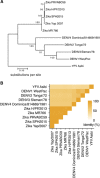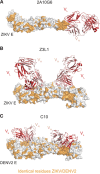Humoral cross-reactivity between Zika and dengue viruses: implications for protection and pathology
- PMID: 28487557
- PMCID: PMC5520485
- DOI: 10.1038/emi.2017.42
Humoral cross-reactivity between Zika and dengue viruses: implications for protection and pathology
Abstract
Zika virus (ZIKV) is a re-emerging mosquito-borne flavivirus that has recently caused extensive outbreaks in Central and South America and the Caribbean. Given its association with Guillain-Barré syndrome in adults and neurological and ocular malformities in neonates, ZIKV has become a pathogen of significant public health concern worldwide. ZIKV shares a considerable degree of genetic identity and structural homology with other flaviviruses, including dengue virus (DENV). In particular, the surface glycoprotein envelope (E), which is involved in viral fusion and entry and is therefore a chief target for neutralizing antibody responses, contains regions that are highly conserved between the two viruses. This results in immunological cross-reactivity, which in the context of prior DENV exposure, may have significant implications for the generation of immune responses to ZIKV and affect disease outcomes. Here we address the issue of humoral cross-reactivity between DENV and ZIKV, reviewing the evidence for and discussing the potential impact of this cross-recognition on the functional quality of antibody responses against ZIKV. These considerations are both timely and relevant to future vaccine design efforts, in view of the existing overlap in the distribution of ZIKV and DENV and the likely spread of ZIKV to additional DENV-naive and experienced populations.
Figures



Similar articles
-
Modulation of Dengue/Zika Virus Pathogenicity by Antibody-Dependent Enhancement and Strategies to Protect Against Enhancement in Zika Virus Infection.Front Immunol. 2018 Apr 23;9:597. doi: 10.3389/fimmu.2018.00597. eCollection 2018. Front Immunol. 2018. PMID: 29740424 Free PMC article. Review.
-
Dengue virus sero-cross-reactivity drives antibody-dependent enhancement of infection with zika virus.Nat Immunol. 2016 Sep;17(9):1102-8. doi: 10.1038/ni.3515. Epub 2016 Jun 23. Nat Immunol. 2016. PMID: 27339099 Free PMC article.
-
Dengue Virus Envelope Dimer Epitope Monoclonal Antibodies Isolated from Dengue Patients Are Protective against Zika Virus.mBio. 2016 Jul 19;7(4):e01123-16. doi: 10.1128/mBio.01123-16. mBio. 2016. PMID: 27435464 Free PMC article.
-
Dengue and Zika Virus Domain III-Flagellin Fusion and Glycan-Masking E Antigen for Prime-Boost Immunization.Theranostics. 2019 Jul 9;9(16):4811-4826. doi: 10.7150/thno.35919. eCollection 2019. Theranostics. 2019. PMID: 31367259 Free PMC article.
-
Cross-reactive dengue virus-derived monoclonal antibodies to Zika virus envelope protein: Panacea or Pandora's box?BMC Infect Dis. 2018 Dec 10;18(1):641. doi: 10.1186/s12879-018-3572-0. BMC Infect Dis. 2018. PMID: 30526531 Free PMC article. Review.
Cited by
-
Neighborhood Violence Impacts Disease Control and Surveillance: Case Study of Cali, Colombia from 2014 to 2016.Int J Environ Res Public Health. 2018 Sep 29;15(10):2144. doi: 10.3390/ijerph15102144. Int J Environ Res Public Health. 2018. PMID: 30274270 Free PMC article.
-
Small-Animal Models of Zika Virus.J Infect Dis. 2017 Dec 16;216(suppl_10):S919-S927. doi: 10.1093/infdis/jix465. J Infect Dis. 2017. PMID: 29267919 Free PMC article. Review.
-
Dengue and Zika Viruses: Epidemiological History, Potential Therapies, and Promising Vaccines.Trop Med Infect Dis. 2020 Sep 23;5(4):150. doi: 10.3390/tropicalmed5040150. Trop Med Infect Dis. 2020. PMID: 32977703 Free PMC article. Review.
-
Pre-Existing Dengue Immunity Drives a DENV-Biased Plasmablast Response in ZIKV-Infected Patient.Viruses. 2018 Dec 29;11(1):19. doi: 10.3390/v11010019. Viruses. 2018. PMID: 30597938 Free PMC article.
-
Comparative Evaluation of Indirect Immunofluorescence and NS-1-Based ELISA to Determine Zika Virus-Specific IgM.Viruses. 2018 Jul 19;10(7):379. doi: 10.3390/v10070379. Viruses. 2018. PMID: 30029548 Free PMC article.
References
-
- Dick GW, Kitchen SF, Haddow AJ. Zika virus. I. Isolations and serological specificity. Trans R Soc Trop Med Hyg 1952; 46: 509–520. - PubMed
-
- Dick GW. Zika virus. II. Pathogenicity and physical properties. Trans R Soc Trop Med Hyg 1952; 46: 521–534. - PubMed
-
- Simpson DI. Zika virus infection in man. Trans R Soc Trop Med Hyg 1964; 58: 335–338. - PubMed
-
- Moore DL, Causey OR, Carey DE et al. Arthropod-borne viral infections of man in Nigeria, 1964–1970. Ann Trop Med Parasitol 1975; 69: 49–64. - PubMed
Publication types
MeSH terms
Substances
Grants and funding
LinkOut - more resources
Full Text Sources
Other Literature Sources
Medical
